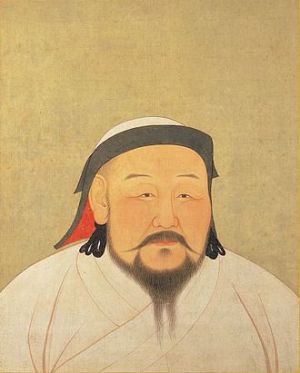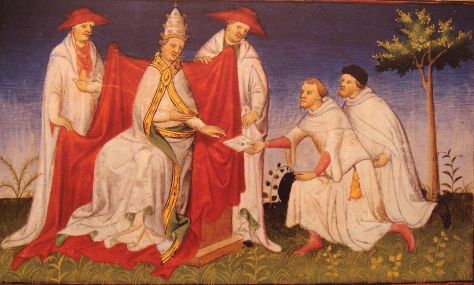.
A 13th-century travelogue titled Livre des Merveilles du Monde (Book of the Marvels of the World) or Devisement du Monde (Description of the World) introduced Europeans to the geography of the Orient and the ethnic customs of its indigenous peoples.
The book described the travels of the Italian merchant traveler Marco Polo between 1276 and 1291, through Asia: Persia, China, Indonesia, Burma, Tibet, Ceylon (now Sri Lanka) and India, and his experiences at the court of Kublai Khan, the fifth Khagan (Great Khan) of the Mongol Empire. The book described Cathay (present-day China) in great detail and its abundance of riches. Though Marco Polo was not the first European to have visited the Far East, he still became famous after the publication of the book.
.

.
Marco Polo was born in Venice on September 15, 1254 to a wealthy Venetian merchant named Niccolò Polo. Marco’s father and his uncle Maffeo Polo being merchants had established trading posts in Constantinople, Sudak in Crimea, and in a western part of the Mongol Empire in Asia.
In 1264, the Polo brothers joined up with a diplomatic mission sent by Hulagu, the ruler of Il-khanate to his brother Kublai Khan, both grandsons of Gengis Khan. They reached the seat of Kublai Khan, the leader of the Mongol Yuan dynasty, in Dadu (present day Beijing, China) in 1266.
.

.
Kublai Khan, the Mongol Emperor, received the Polos well and expressed his interest in Christianity. He then sent them back to Italy with a Mongol named Koeketei as an ambassador to Pope Clement IV. They carried a letter from the emperor requesting the Pope to send 100 educated people to teach Christianity and western customs to his people. He also requested oil from the lamp of the Holy Sepulcher. The emperor also gave them the paiza, a golden tablet a foot long and 3 inches (7.6 cm) wide, to signify certain privileges and authority, allowing them to acquire lodging, horses and food throughout his dominion.
Koeketei left in the middle of the journey, leaving the Polos to travel alone to Ayas in the Armenian Kingdom of Cilicia. From that port city, the Polos sailed to Saint Jean d’Acre, capital of the Kingdom of Jerusalem.
Pope Clement IV died on November 29, 1268. The long sede vacante between the death of Pope Clement IV, and the election of a new pope delayed the Polos from fulfilling Kublai Khan’s request.
In 1269 or 1270, Teobaldo Visconti, then papal legate for the realm of Egypt suggested that the brothers return to Venice and wait for the nomination of the new Pope.
Niccolò Polo once again saw his son Marco, now a teenager, who had been living with his aunt and another uncle in Venice since the death of his mother at a young age.
.

.
In 1271, Theobald Visconti was elected as Pope Gregory X. He received the letter from Kublai Khan brought by the Polo brothers.
The Polo brothers left Venice on their second voyage to the Orient along with a 17-year-old Marco. Unable to recruit the 100 people that Kublai Khan had requested to teach his people, the Polos left with only two Dominican friars: Niccolò de Vicence and Guillaume de Tripoli. They set sail to Acre.
At Acre they joined a caravan of merchants travelling to the Persian port of Hormuz. Soon, bandits attacked their caravan using the cover of a sandstorm to ambush them. The marauding bandits killed many members of the caravan and enslaved the rest, but the Polos managed to escape to a nearby town.
Marco reveled in the adventure, but the two monks after getting a taste of the hard journey ahead of them, soon turned back for home.
When they reached Hormuz they wanted to sail straight to China, but the ships in Hormuz were not seaworthy, so they continued overland through the Silk Road.
The journey was challenging and at times they had to traverse harsh terrain. In what is now Afghanistan, Marco fell ill. He had to retreat to the mountains to recuperate from the illness.
Crossing the Gobi desert, proved long and, at times, arduous. Marco told later: “This desert is reported to be so long that it would take a year to go from end to end. And at the narrowest point it takes a month to cross it. It consists entirely of mountains and sands and valleys. There is nothing at all to eat.“
In 1274, three and a half years after leaving Venice, when Marco was about 21 years old, the Polos reached Kanbaliq or Dadu, the capital of the Yuan dynasty (present day Beijing). Kublai Khan who welcomed them into his summer palace known as Xanadu, a grand marble architectural wonder. The Polos presented the sacred oil from Jerusalem and the papal letters to the Mongol Emperor.
The Polos spent the next 17 years in China under the patronage of Kublai Khan. Niccolo and Maffeo were granted important positions in Kublai Khan’s Court. The Mongol Emperor took a liking to Marco, an engaging storyteller. Marco’s immersed himself into the Chinese culture and mastered four languages. He served as an official in the salt administration and made trips through the provinces of Yunnan and Fukien. At one stage, he was the tax inspector in the city of Yanzhou.
Marco Polo marveled at the use of paper money in the Mongol empire, an idea that had not reached Europe at that time.
Kublai Khan employed Marco Polo as a special envoy. He sent Marco to Burma, India, Tibet and other far-flung areas hitherto never explored by Europeans. Marco was promoted again and again for his work. He served as governor of a Chinese city. Later, Kublai Khan appointed him as an official of the Privy Council.
The Polos asked permission on many occasions to return to Europe, but Kublai Khan liked them so much that he would not agree to their departure.
In 1291, Kublai Khan entrusted the Polos with their last duty. It was to escort the Mongol princess Koekecin to her betrothed, the Il-khan Arghun of the breakaway state of the Mongol Empire in Persia, ruled by the Mongol House of Hulagu.
The Polos departed from the southern port city of Quanzhou with a caravan of several hundred passengers and sailors. They sailed to Sumatra, Ceylon and India. They visited Mylapore, Madurai and Alleppey in India. Marco Polo nicknamed Alleppey as the “Venice of the East.”
The journey was harrowing due to storms and disease. Many perished. By the time they reached Il-khanate in Persia in 1293 or 1294, only 18 people, including the princess and the Polos, were still alive. They came to know that Il-khan Arghun to whom the princess was betrothed had died. They left the Mongol princess Koekecin with the new Il-khan Gaykhatu. The Polos then moved to Trebizond . From there they sailed to Constantinople and then reached Venice in 1295. They had travelled almost 15,000 miles (24,000 km). The Polos returned to Venice with thier fortune converted in gemstones. In Venice, the Polos struggled to converse in their native tongue. Above all, they were unfamiliar to their family.
.

.
Next → Part 2 – The Book “The Travels of Marco Polo”
.
RELATED ARTICLES
- A European in the Orient: Part 2 – The Book “The Travels of Marco Polo” (tvaraj.com)
- A European in the Orient: Part 3 – Did Marco Polo Really Travel to the Far East? (tvaraj.com)
- Niccolò and Maffeo Polo (en.wikipedia.org)
- Marco Polo (en.wikipedia.org)
- The Travels of Marco Polo (en.wikipedia.org)
- Marco Polo Biography – Journalist, Explorer (c. 1254–1324) (biography.com)
- Kublai Khan (en.wikipedia.org)
- Pope Clement IV (en.wikipedia.org)
- Pope Gregory X (en.wikipedia.org)
- Marco Polo’s India (shunya.net)
- 15th Century Chinese Mariners: Part 1 – The Hongwu Emperor(tvaraj.com)
- 15th Century Chinese Mariners: Part 2 – The Yongle Emperor (tvaraj.com)
- 15th Century Chinese Mariners: Part 3 – The Seven Voyages of Zheng He (tvaraj.com)
- 15th Century Chinese Mariners: Part 4 – Zheng He’s fleet (tvaraj.com)
- 15th Century Chinese Mariners: Part 5 – Zheng He’s Seventh Voyage (tvaraj.com)
- 15th Century Chinese Mariners: Part 6 – Did They Reach the Americas Before Columbus? (tvaraj.com)
- Vikings, the First Colonizers of North America: Part 1 – Erik the Red (tvaraj.com)
- Vikings, the First Colonizers of North America: Part 2 – Leif Erikson (tvaraj.com)
- Vikings, the First Colonizers of North America: Part 3 – America Honors Leif Erikson (tvaraj.com)
.

